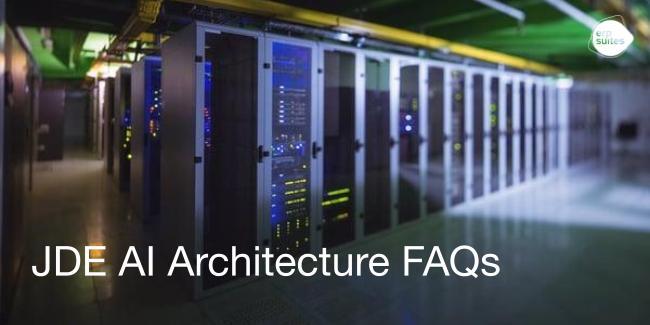
In the intricate realm of JD Edwards, keeping your system operating at its optimal condition is non-negotiable. With technology evolving at lightning speed, JD Edwards upgrades and refreshes are essential to ensure your enterprise resource planning environment remains up to date, secure, and efficient.
This blog post delves into the world of JD Edwards upgrades, including Tools Upgrades, Tech Refresh, and Application Upgrades, exploring their roles in maintaining JD Edwards systems and the nuances that set them apart. By the end, you'll not only understand the importance of these upgrades but also appreciate the long-term value they bring to your organization.
Understanding JD Edwards Upgrades
Before we dive into the specifics, let's establish the basics. JD Edwards upgrades are critical to keeping your system up to date and operating at peak performance. These upgrades come in three main flavors:
Tools Upgrade
A Tools Upgrade focuses on enhancing the tools and technology that power your JD Edwards environment. These upgrades are released periodically as a “tools release” and introduce an enhanced software version encompassing a range of enhancements. This upgrade is integral to keeping your JD Edwards in its optimal operating condition and focuses on:
- User Experience: A Tools Upgrade can significantly improve the user experience by introducing new features and functionalities such as bug fixes and increased user interface intuitiveness.
- System Performance: The latest tools often come with performance enhancements, such as the capabilities of the REST interface provided by the AIS server, which allows for more precise integration with JD Edwards.
While Tools Upgrades bring numerous benefits, they're not without potential drawbacks. Implementation may lead to compatibility issues, and the need to update customizations can be a challenge. It’s also important to be sure your technical elements meet the requirements to take on the release.
The Tech Refresh
A Tech Refresh focuses on updating the technology stack (such as software, hardware, and infrastructure) that underpins your system by providing:
- Stability: A Tech Refresh bolsters system stability, reducing the likelihood of crashes or disruptions.
- Security: By updating components like databases and middleware, you protect your system from vulnerabilities and cyber threats.
- Compliance: Staying up to date with technology ensures compliance with industry standards and regulations.
Similar to Tools Upgrades, Tech Refreshes have their challenges, such as complex updates and potential incompatibility with existing systems. However, the long-term value they offer in terms of system stability, security, and compliance is undeniable. Your JD Edwards system remains a secure fortress for your business data.
The Application Upgrade
The heart of JD Edwards lies in its applications. An Application Upgrade focuses on updating business logic, workflows, and functionalities through:
- Functionality: An Application Upgrade introduces new functionalities and features, ensuring that your system can adapt to evolving business requirements.
- Efficiency: It streamlines workflows and enhances efficiency, optimizing your business processes for smoother operations.
- Support for New Technologies: Upgrading your JD Edwards applications ensures compatibility with the latest technologies and platforms. This can be crucial for integrating with other business systems, adopting new hardware, or taking advantage of emerging technologies.
While Application Upgrades offer tremendous benefits, they pose unique challenges. Data migration, extensive testing, and potential disruptions are part of the process. Yet, the long-term value they bring in terms of functionality, efficiency, and adaptability is unmatched. Your JD Edwards system evolves with your business, ensuring it remains a strategic asset.
Similarities and Differences Between Implementations
There are both similarities and differences in the ways these three types of upgrades are implemented:
Similarities:
- Planning: All three upgrades require meticulous planning to ensure a successful transition.
- Testing: Thorough testing is essential for all types to catch and resolve potential issues.
- Backup and Recovery: Robust backup and recovery plans are necessary for each upgrade to handle unforeseen issues.
Differences:
- Focus: Tools Upgrades primarily focus on technology tools, while Tech Refreshes concentrate on the underlying technology stack. Application Upgrades revamp the business logic and functionalities.
- Challenges: Each type has its unique set of challenges. Tools Upgrades may involve compatibility issues and customization conflicts, Tech Refreshes may require complex updates, and Application Upgrades could lead to data migration complexities and temporary productivity dips.
Potential Drawbacks to Implementation
While the benefits of these upgrades are evident, there are potential drawbacks to consider. Tools Upgrades may disrupt existing customizations and require rework. Tech Refreshes can lead to compatibility issues, and Application Upgrades may entail complex data migration and testing. Proper planning and expertise are crucial to mitigate these potential drawbacks.
Future Facing
In the dynamic world of enterprise resource planning, JD Edwards upgrades ensure your system remains up to date and efficient. Tools Upgrades, Tech Refreshes, and Application Upgrades each play integral roles in maintaining your JD Edwards in its optimal operating condition. While they have their challenges, the long-term value they bring to your organization is immeasurable.
Don't let your JD Edwards system become outdated and stagnant. Embrace upgrades and stay ahead in the ever-evolving landscape of enterprise resource planning. If you need help with any of your upgrades, we’re here for you. Schedule a discovery call for an upgrade assessment.
Leyla Shokoohe is an award-winning journalist with over a decade of experience, specializing in workplace and journalistic storytelling and marketing. As content manager at ERP Suites, she writes articles that help customers understand every step of their individual ERP journey.
Topics:



.png?width=650&height=325&name=Blog%20Images%202_1%20(4).png)
.png?width=650&height=325&name=Blog%20Images%202_1%20(5).png)
.png?width=650&height=325&name=Blog%20Images%202_1%20(3).png)
.png?width=650&height=325&name=Blog%20Images%202_1%20(2).png)
.png?width=650&height=325&name=Blog%20Images%202_1%20(1).png)
.png?width=960&height=540&name=Blog%20Images%20(96).png)

.png?width=960&height=540&name=Blog%20Images%20(90).png)
.png?width=960&height=540&name=Blog%20Images%20(88).png)
.png?width=960&height=540&name=Blog%20Images%20(87).png)
.png?width=960&height=540&name=Blog%20Images%20(86).png)
.png?width=960&height=540&name=Blog%20Images%20(85).png)
.png?width=960&height=540&name=Blog%20Images%20(83).png)
.png?width=960&height=540&name=Blog%20Images%20(82).png)
.png?width=960&height=540&name=Blog%20Images%20(80).png)
.png?width=960&height=540&name=Blog%20Images%20(79).png)
.png?width=960&height=540&name=Blog%20Images%20(78).png)
.png?width=960&height=540&name=Blog%20Images%20(77).png)